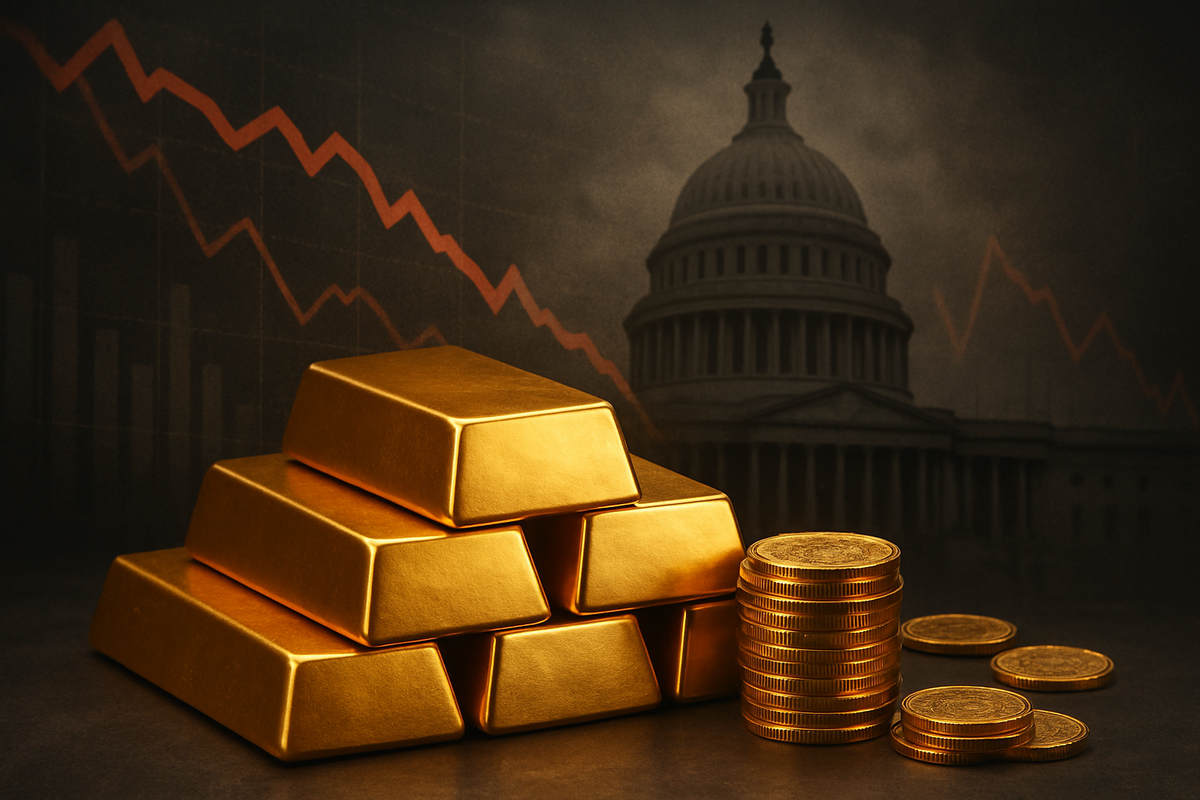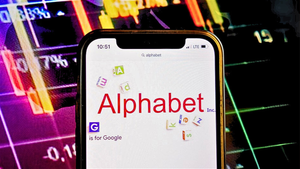
Gold prices have surged for an unprecedented seventh consecutive week, reaching near-record highs as of October 3, 2025. This remarkable rally, with spot gold trading between $3,859.69 and $3,885.73 per ounce and hitting an all-time peak of $3,896.49, underscores a deepening anxiety within financial markets. The primary catalyst for this flight to safety is the ongoing U.S. government shutdown, which commenced on October 1, 2025, exacerbating concerns over economic stability and prompting investors to seek refuge in the traditional safe-haven asset.
The sustained upward trajectory of gold, marking an impressive 46-48% annual gain, signals a profound shift in investor sentiment. As the political deadlock in Washington persists, delaying crucial economic data and disrupting federal services, the allure of gold as a hedge against uncertainty and potential inflation grows stronger. This confluence of political gridlock, expectations of impending interest rate cuts by the Federal Reserve, and persistent geopolitical tensions has created a potent environment for gold's ascent, positioning it for one of its strongest calendar-year performances in decades.
Unpacking the Crisis: Gold's Ascent Amidst Washington's Stalemate
The current surge in gold prices is a direct reflection of a multifaceted crisis gripping the U.S. economy and political landscape. Gold's seven-week winning streak culminated in spot prices touching nearly $3,897 per ounce, a significant psychological and technical level that analysts believe could soon give way to the $4,000 mark if current conditions persist. This sustained rally began shortly after the Federal Reserve hinted at a more dovish stance, with market participants now pricing in a high probability (around 97%) of a 25-basis-point rate reduction in October, followed by further cuts in December. Lower interest rates diminish the opportunity cost of holding non-yielding assets like gold, making it a more attractive investment.
The most immediate and impactful event driving this rally is the U.S. federal government shutdown, which began at 12:01 a.m. ET on October 1, 2025. This marks the third shutdown under President Donald Trump's administration and the first major one since 2018-2019. The legislative deadlock stems from a failure by Congress to agree on a short-term funding bill or a longer appropriations package, primarily due to disagreements over federal spending levels, foreign aid, and healthcare funding. Both the Senate's competing Democratic and Republican proposals have failed to garner the necessary 60 votes, indicating a prolonged impasse. Key players involved include the President, congressional leaders from both parties, and, indirectly, the Federal Reserve, which faces increased difficulty in making informed monetary policy decisions due to the ensuing "data vacuum."
Initial market reactions have been characterized by a pronounced "risk-off" sentiment. The VIX (CBOE Volatility Index), often referred to as the market's fear gauge, has risen over 3%, signaling increased investor anxiety. The U.S. dollar index has been in a "freefall," further bolstering gold's appeal to international buyers as it makes the dollar-denominated commodity cheaper. While the S&P 500 (SPX) has historically shown modest and temporary impacts during past shutdowns, the current environment of heightened economic fragility and the threat of permanent federal worker layoffs suggest that this shutdown could have more significant and lasting effects on equity markets. Bond markets are also reacting, with yields potentially reflecting increased demand for safe-haven U.S. Treasury bonds, even amidst the political uncertainty. The delay in critical economic data releases—such as the non-farm payrolls report, Consumer Price Index updates, and retail sales figures—is creating a significant blind spot for investors and policymakers alike, fueling further uncertainty.
Corporate Fortunes: Winners and Losers in a Gold-Backed Economy
The sustained rise in gold prices and the economic instability caused by the government shutdown create a distinct landscape of winners and losers among public companies. Gold mining companies, as direct beneficiaries of higher commodity prices, are poised for significant gains. Companies like Barrick Gold Corp. (NYSE: GOLD), Newmont Corp. (NYSE: NEM), and Agnico Eagle Mines Ltd. (NYSE: AEM) are likely to see improved revenue and profitability margins, assuming their operational costs remain stable. Higher gold prices directly translate to increased top-line growth, potentially leading to stronger stock performance and increased investor interest in the precious metals sector. Companies specializing in gold exploration and development could also attract more capital, accelerating their projects.
Conversely, sectors highly dependent on government contracts or regulatory approvals face considerable headwinds. Defense contractors, IT service providers to federal agencies, and infrastructure companies with significant government exposure may experience delayed payments, contract freezes, or even cancellations, impacting their cash flow and earnings. Companies like Lockheed Martin Corp. (NYSE: LMT) or Raytheon Technologies Corp. (NYSE: RTX), while diversified, could feel the pinch from prolonged federal spending freezes. Furthermore, the slowdown in regulatory approvals from agencies like the FDA and EPA could delay product launches or project commencements for pharmaceutical companies like Pfizer Inc. (NYSE: PFE), biotech firms, and energy companies, creating significant operational and financial uncertainty.
Beyond direct government ties, companies sensitive to consumer spending and overall economic confidence could suffer. Retailers, hospitality chains, and discretionary consumer goods manufacturers, such as Amazon.com Inc. (NASDAQ: AMZN) or Walmart Inc. (NYSE: WMT), might see reduced sales as federal workers face furloughs and the broader public becomes more cautious with their spending due to economic uncertainty. Financial institutions, including major banks like JPMorgan Chase & Co. (NYSE: JPM) and Bank of America Corp. (NYSE: BAC), could face increased credit risk if the shutdown leads to widespread economic distress or delays in loan processing. The "data vacuum" also makes it harder for these companies to make informed strategic decisions, adding another layer of risk to their operations.
Broader Implications: A Shifting Economic Paradigm
The current surge in gold prices, driven by the government shutdown, is not an isolated event but rather fits into broader industry trends emphasizing risk aversion and diversification. The persistent geopolitical tensions, including the Russia-Ukraine war and unrest in the Middle East, have already reinforced gold's traditional role as a safe-haven asset, a trend that the U.S. political instability is now amplifying. This event highlights a growing global distrust in the stability of fiat currencies and government debt, pushing central banks, particularly in emerging markets like China, to aggressively increase their gold reserves as part of de-dollarization initiatives. This structural demand provides a robust floor for gold prices, irrespective of short-term market fluctuations.
The ripple effects on competitors and partners are significant. Countries heavily invested in U.S. Treasuries may reassess their portfolio allocations, potentially accelerating a move towards other reserve assets, including gold, to mitigate exposure to U.S. political risk. This could further weaken the U.S. dollar and strengthen gold's position on the global stage. Regulatory bodies like the U.S. Securities and Exchange Commission (SEC) are operating with extreme limitations during the shutdown, which can delay IPOs, mergers and acquisitions, and other corporate actions. This regulatory bottleneck creates uncertainty for businesses planning capital market activities and could force them to postpone crucial strategic moves, impacting broader market liquidity and investment.
Historically, government shutdowns have often had a temporary economic impact, with GDP losses typically recouped once funding is restored. However, the current situation is viewed as riskier due to the precarious state of the global economy, elevated inflation concerns, and the threat of permanent job cuts for federal workers. The 2018-2019 shutdown, for instance, resulted in a permanent loss of about $3 billion from the U.S. economy and coincided with a 7% decline in consumer sentiment. The current shutdown, if prolonged, could lead to more significant and lasting damage, potentially causing an additional 43,000 unemployed people and reducing consumer spending by $30 billion per month. This historical context suggests that while markets might initially shrug off short shutdowns, a protracted impasse could trigger a more severe and sustained economic downturn, reinforcing gold's appeal as a crisis hedge.
The Road Ahead: Navigating Uncertainty
Looking ahead, the short-term trajectory of gold prices is heavily dependent on the duration and resolution of the government shutdown. If the political impasse persists, gold is likely to maintain its upward momentum, potentially breaching the $4,000 per ounce mark by year-end or early 2026. A swift resolution, however, could lead to a temporary pullback as some risk-off sentiment unwinds, though the underlying factors of expected interest rate cuts and geopolitical tensions are likely to keep prices elevated. In the long term, the increasing central bank demand and gold's role as an inflation hedge suggest a sustained positive outlook, with analysts expecting prices to stabilize in the $3,500-$4,000 range.
Potential strategic pivots for businesses include diversifying supply chains away from heavy reliance on federal contracts, exploring international markets to mitigate domestic political risks, and strengthening balance sheets to weather potential economic downturns. For investors, opportunities may emerge in gold mining stocks and gold-backed exchange-traded funds (ETFs), as well as in defensive sectors that are less susceptible to economic volatility. Challenges include navigating the "data vacuum" created by the shutdown, which complicates fundamental analysis and market forecasting, and managing increased market volatility across asset classes.
Several scenarios could unfold. A quick resolution to the shutdown, perhaps by mid-October, might lead to a modest market rebound and a slight correction in gold prices. However, a prolonged shutdown, extending into November or beyond, could trigger a more significant economic slowdown, potentially pushing the Federal Reserve to implement more aggressive interest rate cuts, further bolstering gold's appeal. Another scenario involves a significant escalation of geopolitical tensions, which, combined with domestic instability, would create a "perfect storm" for gold, driving its price to unprecedented levels. The key outcome to watch for is how quickly and effectively policymakers can restore confidence in the U.S. economy and political system.
Concluding Thoughts: Gold's Enduring Appeal in Turbulent Times
The seven-week rally in gold prices, propelled by the ongoing government shutdown and broader economic anxieties, serves as a stark reminder of the precious metal's enduring appeal as a safe-haven asset. Key takeaways include the significant impact of political instability on market sentiment, the growing expectation of interest rate cuts, and the increasing global demand for gold as a hedge against inflation and currency debasement. The current environment underscores a "risk-off" mentality among investors, who are actively seeking to shelter their portfolios from the uncertainties of a volatile global economy.
Moving forward, the market will remain highly sensitive to developments in Washington regarding the shutdown, as well as signals from the Federal Reserve concerning monetary policy. While a resolution to the shutdown may temporarily ease some pressure, the underlying macroeconomic and geopolitical factors supporting gold prices are likely to persist. Investors should watch for any signs of de-escalation in political tensions, clarity on interest rate policies, and shifts in central bank gold purchasing trends. The current rally in gold is not merely a reaction to a temporary crisis but potentially a harbinger of a more fundamental shift in how investors view risk and allocate capital in an increasingly uncertain world. Gold's current shine reflects a deep-seated concern about the stability of the broader financial landscape, making it a critical asset to monitor in the coming months.
This content is intended for informational purposes only and is not financial advice.







